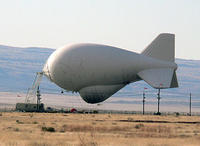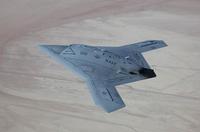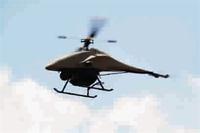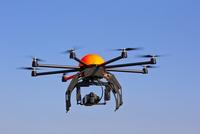-
World's smallest drone may be a search-and-rescue tool
Researchers have designed, built, and tested the world’s smallest open source autopilot for small unmanned aircraft. A smaller and lighter autopilot — it weighs only 1.9 grams — allows these small flying robots to fly longer, fit into narrower spaces, or carry more payloads such as cameras. This makes them more suitable to be used, for example, rescue operations.
-
-
DHS takes control of Arizona border blimp, grounding it for repairs

A 208-foot long white blimp has been floating two miles above Yuma Proving Ground, Arizona, using radar continuously to scan the area along the border, looking for low-flying aircraft drug smugglers use to bring drugs into the United States. The sensors on board can detect activity in distances of up to 230 miles. The blimp, had been operated by the U.S. Air Force, but DHS has now assumed responsibility for it. It is one of eight aerostats deployed along the U.S. southern border.
-
-
Drones help kill bugs dead
The Florida Keys Mosquito Control District is considering using a drone to spot shallow-water pools where mosquitoes breed along the Keys. The 2.2-pound, 2.5-foot-long drone would use infrared cameras to locate the shallow pools and allow the district rapidly to treat those areas with larvicide.
-
-
Teams compete in challenging robotic helicopter competition

A U Michigan student team took part in an autonomous aerial vehicle competition. Their task: build a 3-pound flying machine that can, under its own control, take off, fly through a window into a model building, avoid security lasers, navigate the halls, recognize signs, enter the correct room, find a flash drive in a box on a desk, pick it up, leave a decoy, exit, and land in under ten minutes. Beyond military uses, autonomous vehicle they built could one day be used to survey collapsed buildings or inspect hard-to-get-to parts of bridges and other infrastructure. An offshoot group from a previous U-M team is working to commercialize the U-M technology through a startup called SkySpecs, which inspects windmills.
-
-
Israeli drone strike, in coordination with Egypt, destroys militants’ rockets deployed on Egyptian territory
The growing intelligence cooperation between Egypt and Israel was in evidence earlier today (Friday) when the Israel Air Force (IAF), in coordination with the Egyptian military, used drone strikes to destroy ready-to-launch rockets and rocket launchers on Egyptian territory, killing five Egyptian militants in the process. The rockets were deployed on Thursday in a desert area near the town of Rafah, and were discovered by an Egyptian surveillance fly-over.
-
-
Navy uses drones for help with radar, communications

Scientists recently launched unmanned aerial vehicles (UAVs) from a research vessel in a significant experiment that could help boost the U.S. Navy’s radar and communications performance at sea.
Sailing off Virginia Beach, Virginia, from 13 to 18 July, the Office of Naval Research’s (ONR) Research Vessel (R/V) Knorr explored ocean and atmospheric weather variations that can change the angle that radar and radio waves bend, making it more difficult for ships to remain undetected and hindering their ability to communicate or locate adversaries.
-
-
FAA warns Colorado town about drone hunting

The town of Deer Trail, Colorado is considering the idea of allowing town residents to purchase hunting permits to shoot down drones operated by the government. The proposed permit would cost $25, and residents would be entitled to a $100 reward from the city for a successful attempt to shoot down a drone, if the drone’s “markings and configuration are consistent with those used on any similar craft known to be owned or operated by the United States federal government.”
-
-
Navy drone lands on ship without human assistance
A U.S. Navyexperimental drone has executed several landings on the USS George H.W. Bush, marking an advance in robotic aviation. The drone calculated, without human assistance, how fast to approach the ship, when to put its wheels down, and when to hit the brakes.
-
-
CBP drones may be armed with non-lethal weapons
Customs and Border Protection (CBP) currently has eight Predator drones used on the northern and southern borders, and two more drones watching the Caribbean. The drones are equipped with high-tech cameras. Critics say drones are not an efficient way to monitor the border, and that they lead to few arrests and seizures. Other critics are worry about something else: a recent CBP report show that the agency is considering arming these drones with “expendables or non-lethal weapons designed to immobilize [targets of interest].”
-
-
States move to draft their own drone laws

Advances in drone technology and drop in prices have led media and other organizations, and even private citizens, to purchase drones to do their own investigations. Several states have now drafted their own drone laws.
-
-
Studying how journalists and private citizens use of drones
Newly published research offers a groundbreaking perspective on the controversial use of unmanned aerial vehicles in journalism and mass communication, or “drone journalism.” Until now, there has been no formal research and academic writing on the use of smaller drones by news organizations and private citizens.
-
-
GOP lawmakers want stronger border security provisions in immigration bill
A border security amendment to the immigration reform bill, offered by Senator Chuck Grassley (R-Iowa), was defeated by a 57-43 vote last Thursday. Republican senators who supported Grassley’s amendment said they were concerned about a repeat of the 1986 scenario: the Reagan administration pushed through Congress an amnesty for illegal immigrants then residing in the United States, but without bolstering security along the U.S.-Mexico border, prompting millions of illegal immigrants to cross the border in the following decades. Several GOP lawmakers are offering their own border security amendments to the immigration overhaul bill.
-
-
Sen. Rubio proposes that Congress, not DHS, devise border security plan
Senator Marco Rubio (R-Florida), a member of the bipartisan group which drafted the immigration bill which passed the Senate Judiciary Committee and which will be brought to the floor of the Senate next week, is working on a proposal which will dramatically change the approach to devising and assessing border security in the bill. The bill now has DHS entrusted with the responsibility of devising a border security plan and determining whether the plan has been adequately implemented. Rubio proposes that Congress would assume these responsibilities, saying that the current plan for borer security is not robust enough to convince many Republican lawmakers to support the immigration bill.
-
-
Texas Senate bans using drones to take photos, videos without subjects’ permission
Last Sunday the Texas State Senate passed, by a 26-5 vote, a law banning citizens from using drones to take photographs or videos. The legislation will make using a drone to take photos or videos of people without their permission a Class C misdemeanor, which could lead to a $500 fine. Distributing photos or videos taken from a drone will be a Class B misdemeanor, and civil liabilities could add up to $10,000.
-
-
Firefighters, FAA weighing the use of drones for wildfires
With the wildfire season already claiming land and homes in the Western United States, federal government firefighters are considering the use of drones outfitted with cameras to map out the size and speed of a wildfire.
-
More headlines
The long view
Using Drone Swarms to Fight Forest Fires
Forest fires are becoming increasingly catastrophic across the world, accelerated by climate change. Researchers are using multiple swarms of drones to tackle natural disasters like forest fires.
Testing Cutting-Edge Counter-Drone Technology
Drones have many positive applications, bad actors can use them for nefarious purposes. Two recent field demonstrations brought government, academia, and industry together to evaluate innovative counter-unmanned aircraft systems.
